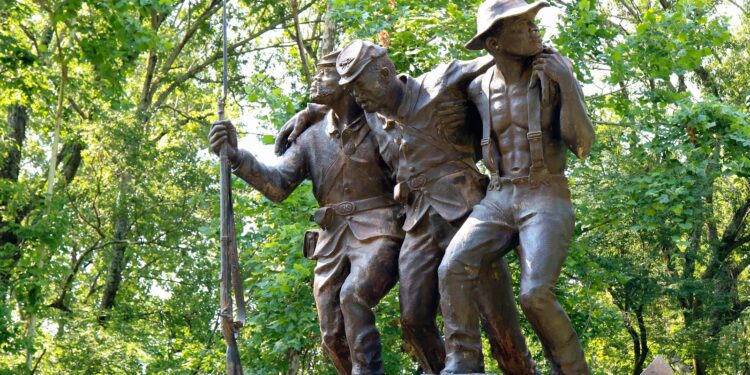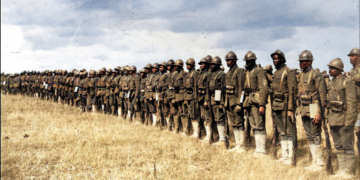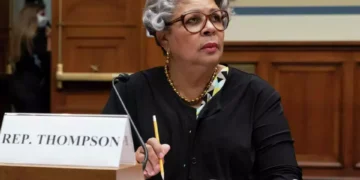April 22, 2025 Story by: Editor
The Mississippi African American monument is a 9-foot tall, 3,000-pound bronze sculpture standing on a pedestal of Black African granite. The monument honors the 1st and 3rd Mississippi Infantry Regiments, African Descent, and all Mississippians of African descent who participated in the Vicksburg Campaign. These United States Colored Troops played a key role in the Union victory at Milliken’s Bend on June 7, 1863.
The identified soldiers had enlisted in the Vicksburg-based 1st Mississippi Infantry (African Descent) as the town was under federal occupation. In early 1864, 18 soldiers and two white officers traveled by boat some 95 miles (153 kilometers) north along the Mississippi River to Chicot County, Arkansas, to forage for crops to feed people and horses.
On Feb. 14, 1864, at Ross Landing near the town of Lake Village, irregular Confederate troops from Missouri shot the Union soldiers and officers, killing most and leaving some for dead. They used the Union soldiers’ own bayonets to impale the dead and wounded, pinning them to the ground, according to research.
The monument features three men: centrally, a wounded black soldier who is being aided by a black soldier in uniform and a civilian laborer in farm attire. The civilian laborer looks back symbolically at the life of enslavement they are leaving behind, the wounded soldier’s face depicts the pain and sacrifices of the present war, while the uniformed soldier looks forward into a hopeful future.
Pvt. Henry Berry, Pvt. Calvin Cathron, 1st Lt. Thaddeus Cock, Pvt. Howard Dixon, Corp. Fleming Epps, Pvt. Ruffian Epps, Corp. Peter Everman, Pvt. Charles Farrar, Pvt. Henry Ford, Pvt. John Genefa, Pvt. Anthony Givens, Pvt. Richard James, Sgt. Tony McGee, Sgt. Noah Powell, Pvt. Thomas Ransom, 1st Sgt. James Spencer, Pvt. Isaac Stanton, Pvt. Isom Taylor, Corp. Nelson Walker, Pvt. James H. Boldin.
The 13 Black men killed in the massacre were initially buried at Ross Landing, and later interred in the cemetery as unknowns. Three more were wounded and died during or shortly after the Civil War, and also were buried as unknowns. Two others survived until 1918. The two white officers’ bodies had been identified and sent home to Ohio and Indiana for burial during the war.
While the American Renaissance movement of art that influenced many of the monuments in the park ended in 1917, the sculptor of this monument– Dr. J. Kim Sessums, a Mississippi native — still utilized some of the key features of the movement, like his focus on anatomical proportions. The three male figures of the sculpture maintain anatomical, proportional, and historical accuracy.
This monument was dedicated on February 14, 2004 and stands as one of the largest tributes to African American soldiers on any Civil War battlefield within the National Park Service.
The African-American Monument is located on the south side of Grant Avenue between milepost 4.3 and 4.4. Erected by the State of Mississippi at a cost of $300,000, including $25,000 contributed by the City of Vicksburg, the sculpture is the work of Dr. Kim Sessums, from Brookhaven, Mississippi.
The monument consists of three bronze figures on a base of black African granite — two black Union soldiers, and a common field hand. The field hand and one soldier support between them the second soldier, who is wounded and represents the sacrifice in blood made by black soldiers on the field of battle during the Civil War. The field hand looks behind at a past of slavery, while the first soldier gazes toward a future of freedom secured by force of arms on the field of battle.
By the end of the Civil War, over 178,000 black soldiers saw service with the Union army, while as many as 18,000 African-Americans joined the Union navy. The Confederate Armies would rely heavily upon slave-labor for intrastructure projects, such as constructing earthworks, fortifications, and other support functions.
African-American participation in the Civil War had far-reaching effects and implications for the black servicemen themselves, their white comrades in arms, and the society of which they were struggling to become a part and gain respect.
The campaign, siege, and defense of Vicksburg provides two of the earliest instances of African-American soldiers serving in combat during the Civil War. At Port Hudson in May of 1863, and Milliken’s Bend the following month, African-Americans proved their mettle on the field of battle, thus quieting some of their harshest critics and winning the confidence of others. The contributions of those men, and others like them who served both North and South either enslaved or free during the Vicksburg campaign is commemorated on the grounds of Vicksburg National Military Park by the erection of the Mississippi African-American Monument.
In recent years, the National Park Service has broadened how it presents history in parks nationwide. In the Vicksburg military park, which is dotted with more than 1,400 monuments, markers and tablets and is one of the largest tourist attractions in Mississippi, drawing visitors from around the globe, the visitor center now includes information about Black history, and a monument to Black soldiers was dedicated 20 years ago.
Vicksburg National Cemetery was established in 1866 and now holds more than 18,000 graves — veterans from six wars and a few former park employees. More than 17,000 of them fought for the Union in the Civil War, including more than 5,500 Black soldiers, designated by the U.S. War Department in 1863 as United States Colored Troops.
Vicksburg is the largest cemetery for Union soldiers and sailors, its dead brought from Mississippi, Louisiana, Arkansas and other states. Nearly 13,000 are buried as unknown.
About 5,000 Confederate soldiers are buried in a city cemetery in Vicksburg, outside the military park.
In 2004, Vicksburg National Military Park dedicated a monument honoring the Black soldiers who fought in the Vicksburg Campaign. The troops were pivotal in a Union victory at Milliken’s Bend, Louisiana, along the Mississippi River north of Vicksburg, in June 1863. Robert Major Walker, a historian elected as Vicksburg’s first Black mayor in 1988, proposed the monument in 1999 after spending years doing research and securing money for it.
Source: National Park Services

















